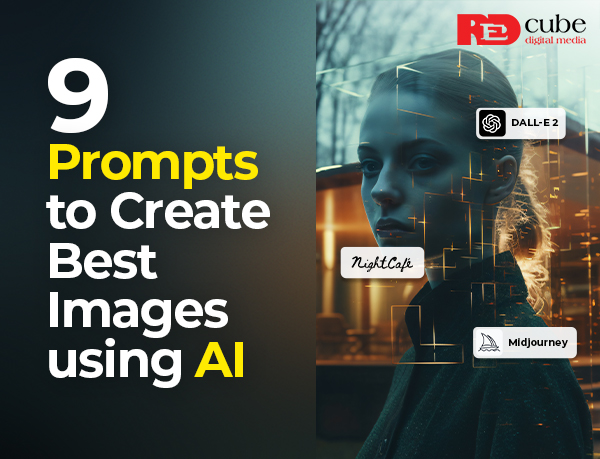Are you tired of struggling to bring your creative ideas to life? Do you wish you could magically turn your words into stunning visuals? Well, guess what? Thanks to the latest AI technology, you can now create breathtaking images from mere descriptions! And the best part? You don’t need to be a professional designer or artist to do it!
With the help of AI image generators, anyone can unleash their creativity and take their visual content to the next level. So, are you ready to join the visual content revolution? Let’s explore the exciting possibilities of AI image generators together!
To help you unlock the full potential of AI image generation, here are 9 creative prompts to get you started:
1. Leveraging Details for Depth and Realism
AI image generators thrive on specifics. The more details you provide in your prompt, the more refined and realistic the generated image will be. Instead of a generic request for “a cat,” try something like “a fluffy orange tabby cat basking in the warm sunlight streaming through a window.”
2. Playing with Style and Mood
Want your image to evoke a specific mood or artistic style? Include keywords related to the desired aesthetic. For instance, “a watercolor painting of a majestic mountain range at sunrise” will produce a very different result from “a neon-drenched cityscape in a cyberpunk art style.”
3. Referencing Existing Works
If you have a particular artistic style or reference image in mind, you can use it as a starting point for your prompt. Try something like “an image in the style of Van Gogh depicting a starry night over a field of sunflowers.” Keep in mind that copyright restrictions may apply, so it’s important to use this prompt for inspiration only.”
4. Adopting Fantasy and Imagination
The beauty of AI image generation lies in its ability to bring fantastical concepts to life. Let your imagination run wild! Prompt the AI to generate “a majestic griffin soaring through a bioluminescent forest” or “a friendly robot reading a book to a group of curious children.”
5. Experimenting with Different Perspectives
The perspective from which an image is viewed can significantly impact its storytelling potential. Consider including details about the perspective in your prompt. For example, “a panoramic view of a bustling city marketplace from a hot air balloon” or “a close-up view of a raindrop splashing onto a vibrant flower petal.”
6. Incorporating Action and Movement
Static images are great, but AI image generators can also capture a sense of movement and dynamism. Try prompting the AI to generate “a snowboarder catching air during a trick on a snow-capped mountain” or “a pod of dolphins leaping out of the crystal-clear ocean water.”
7. Adding Emotional Context
Images can evoke a range of emotions. Consider incorporating emotional cues into your prompt. For instance, “a serene landscape painting depicting a peaceful meadow bathed in the golden light of sunset” or “a close-up portrait of a woman with a determined expression on her face.”
8. Playing with Scale and Proportion
AI image generators can create images that defy the laws of physics. Play with scale and proportion in your prompts. For example, “a tiny house nestled inside the branches of a giant oak tree” or “a person holding a planet in the palm of their hand.”
9. Combining Disparate Concepts
Surrealism and juxtaposition can be incredibly eye-catching. Don’t be afraid to combine seemingly unrelated concepts in your prompts. Try something like “a clock melting onto a chessboard” or “a majestic lion with wings soaring through a starry night sky.”
Beyond the Prompts: Additional Tips for Success
While these prompts provide a springboard for your creativity, here are some additional tips to maximize your success with AI image generation:
- Start Simple
- Refine and Iterate
- Use High-Quality AI Generators
- Provide Feedback
Begin with clear and concise prompts before adding complexity.
Don’t be afraid to experiment with different wording and phrasing to achieve the desired outcome.
Different AI generators have varying capabilities. Explore options like NightCafe Creator, Dall-E 2, and Midjourney to find one that suits your needs.
Many AI generators allow you to provide feedback on generated images to further refine the results.
The Future of AI Image Generation
AI image generation technology is still evolving, but its potential is undeniable. As algorithms become more sophisticated and user interfaces more intuitive, we can expect even more powerful and accessible tools for creating stunning visuals.
This technology has the potential to democratize creative expression, making it possible for anyone to generate high-quality visuals regardless of artistic skill.
Here are some exciting possibilities for the future of AI image generation:
- Enhanced Design Workflows
- Personalized Marketing Materials
- Educational Tools
- Accessibility for People with Disabilities
- Prototyping and Product Development
- Breaking Creative Block
Designers can leverage AI to generate concept art variations, explore visual directions with clients, and create mockups in a fraction of the time.
Marketers can use AI to create targeted and visually appealing marketing materials that resonate with specific audiences.
AI image generators can be used to create interactive and visually engaging educational content, making learning more immersive and accessible.
AI image generation can empower people with visual impairments to create visual representations of their ideas and stories.
Product developers can use AI to generate rapid visual prototypes, accelerating the design and iteration process.
Artists can utilize AI to overcome creative roadblocks by generating unexpected visual ideas and sparking new inspiration.
Challenges and Considerations
While the potential benefits of AI image generation are vast, there are also challenges to consider:
- Copyright and Ownership
- Bias and Representation
- Over-reliance on Automation
As AI-generated images become more sophisticated, copyright issues surrounding ownership and creative authorship will need to be addressed.
AI algorithms are trained on existing data sets, which can perpetuate biases. It’s crucial to be mindful of potential biases in the generated images and to use AI tools responsibly.
While AI can be a powerful tool, it’s crucial to maintain a balance between human creativity and AI-generated content.
The Final Note: 9 Prompts to Create Best Images using AI
AI image generation represents a significant leap forward in the world of visual content creation. By welcoming this technology and using it thoughtfully, you can unlock a new dimension of creative possibilities. So, experiment with different prompts, explore various AI tools, and see where your imagination takes you!
What are your thoughts on AI image generation? Have you tried using AI to create visuals? Share your experiences and questions in the comments section below!
FAQs: 9 Prompts to Create Best Images using AI
Q: What are some popular AI image generators?
A: Several AI image generators are available, each with its own strengths and weaknesses. Here are a few popular options:
- NightCafe Creator
- Dall-E 2
- Midjourney
Q: How much do AI image generators cost?
A: The cost of using AI image generators varies depending on the platform and the desired features. Some offer free trials or limited-use plans, while others require paid subscriptions.
Q: Are AI-generated images considered art?
A: The debate surrounding AI-generated art is ongoing. While AI can create visually striking images, the question of whether they constitute art in the traditional sense remains open to interpretation.
We hope this article has given you a comprehensive overview of AI image generation and its potential applications. As this technology continues to evolve, the possibilities for creative expression are truly limitless.



